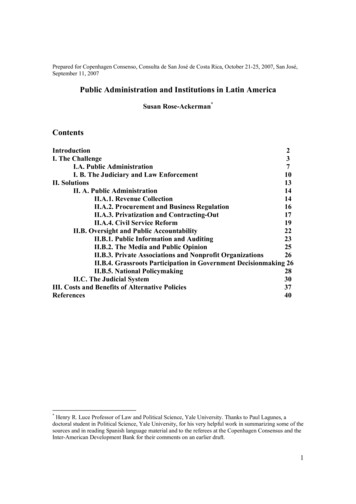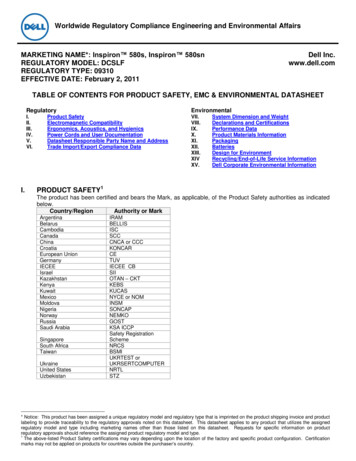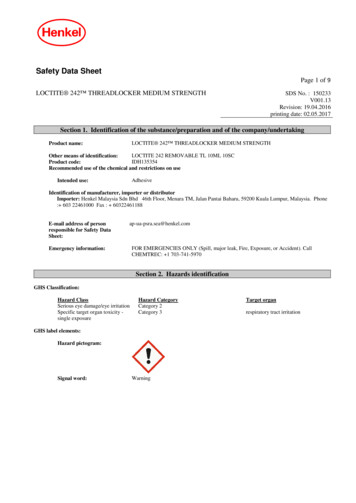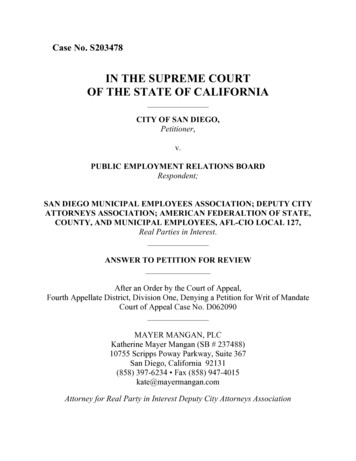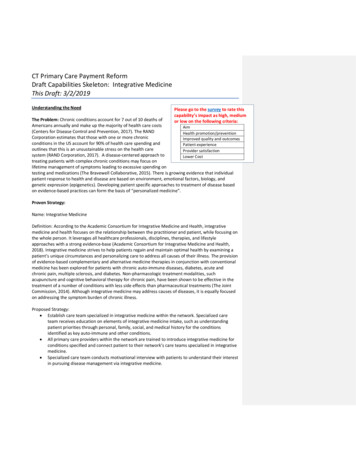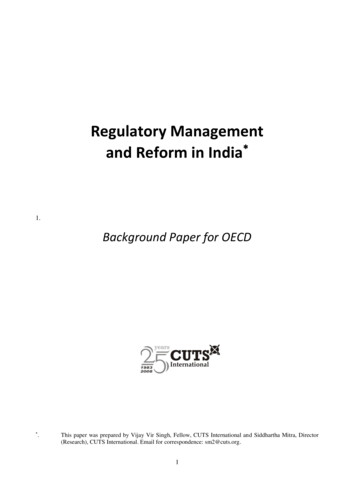
Transcription
Regulatory Management and Reform in India1.Background Paper for OECD .This paper was prepared by Vijay Vir Singh, Fellow, CUTS International and Siddhartha Mitra, Director(Research), CUTS International. Email for correspondence: sm2@cuts.org.1
TABLE OF CONTENTS1. Introduction .42. Rationale for Regulation and its Typology .52.1 Typology of regulation in India.62.2 Listing of major regulations .93. Institutional Landscape for Business in India .113.1 Business regulations enforced by the Government of India .113.2 State government business regulations .133.3 Trends .164. Sector Regulation in India .164.1 Trends .174.2 Sector studies.185. Drivers of Change .225.1 Business regulation .225.2 Sector regulators .246. Importance of Interaction between Policy Makers and Regulators and its Current Status .267. Participation of Stakeholders in the Regulatory Process .278. Prevailing Practices of Sector Regulators for Tackling Market Failure andAnti-competitive Practices.288.1. Competition Authority versus sector regulators .288.2 Actual implementation of regulations .299. Management Practices in Regulation .319.1 Consumer redress .319.2 State of inventories of regulations .339.3 Window system .3310. Mechanisms for Ensuring Regulatory Coherence .3411. Gap between Promulgation and Implementation of Regulation andUnderlying Institutional Weaknesses .3511.1 Institutional causes .3611.2 A review of available instruments to assess regulatory quality.3712. Government‟s Plans for the Future .3713. Gaps in Literature on Regulation .3913.1 Perceptions of stakeholders are inadequately captured .3913.2 Lack of data on compliance and enforcement .39Conclusion .392
TablesTable 1. List of major regulations in India.9Table 2. Approvals/clearances required for doing business and correspondingagencies granting the same .14Table 3. Business registration process .15Table 4. Status of sector specific regulations .17Table 5. Doing business in India: a comparison .23BoxBox 1. Redressal mechanism in the telecom sector .32Box 2. Regulatory framework for power sector .353
1. IntroductionRegulation refers to “controlling human or societal behaviour by rules or regulations or alternatively arule or order issued by an executive authority or regulatory agency of a government and having the forceof law”.1 Regulation covers all activities of private or public behaviour that may be detrimental to societalor governmental interest but its scope varies across countries. It can be operationally defined as “taxes andsubsidies of all sorts as well as explicit legislative and administrative controls over rates, entry, and otherfacets of economic activity”.2 The rules laid down by regulation are supported by penalties or incentivesdesigned to ensure complianceThere are two main theories regarding the genesis of economic regulation. One is the "public interest"theory which conceives regulation as arising from the need to rein in the free exercise of market forces andconsumer and producer impulses in cases where such a display can act as an obstacle to the maximisationof societal well being or to remove externally applied obstacles to market forces when their play isdesirable. In certain cases, regulation is also justified by this school on equity grounds. An alternativetheory is that of „capture‟ espoused by a variety of realists drawn from varied professional and academicbackgrounds who see regulation as being supplied in response to the demands of interest groups strugglingamong themselves to maximise the incomes of their members.3 This school, therefore, gives importance topolitical economy factors which get manifested in the unequal bargaining powers of different vestedinterest groups which in turn result in their unequal influence over regulatory rules/norms and henceoutcomes. In other words, regulation is seen as a tool which can be manipulated by different interestgroups to their advantage using their respective bargaining powers with the regulating machinery.It would be overly simplistic to label one theory as „superior‟ to the other on the basis of their abilitiesto characterise reality, given the complexities typifying economic activity. While the „public interesttheory‟ can be defended on normative grounds (i.e. regulation as conceived by it is necessary to maximisewelfare and bring about equity) the „capture theory‟ reflects quite well how regulatory frameworks can bemanipulated by powerful interest groups to their own advantage. In other words, the former focuses onwhat “should be” whereas the latter concentrates on what “could be” in real world situations. Therelevance of these schools to real world situations would vary across countries and within each countryacross sectors depending on the strength of regulatory institutions, often seen as being positively affectedby the level of economic development, and the spread and relative strengths of vested interest groupsIndia started developing regulatory institutions with the introduction of reforms in 1991. But theregulatory environment which has developed over a period of time does not seem homogeneous acrosssectors. India still ranks very low in terms of the enabling nature of its business environment andunnecessary regulatory burdens are imposed upon business and investors.The objective of this paper is to evaluate the regulatory structure and status of regulation in India. It isstructured as follows. Section 2 explains the rationale for regulation and details its typology. Sections 3 and4 examine in detail business and sector regulation respectively as well as associated institutionallandscapes. Section 5 elaborates on and evaluates the drivers of change in regulation and the underlyinginstitutional landscape. Sections 6 and 7 carry this discussion further by looking at the factors which affectthe regulatory environment. The rationale for and current status of interaction between policy makers andregulators is examined in Section 6 while participation of stakeholders in the regulatory process isexamined in Section 7.1.Regulation (2009), Merriam-Webster Online Dictionary, ard A .Posner (2004), “Theories of Economic Regulation”, Working Paper, No. 41, Center forEconomic Analysis of Human Behavior and Social Institutions.3Ibid.4
Sections 8 and 9 are devoted to a study of actual regulatory practices prevailing in the Indianeconomy: practices of sector regulators for tackling market failure and anti-competitive practices(Section 8) and management practices in regulation (Section 9).Having examined the details of sector regulatory processes through selective illustration, themanagement of the overall regulatory environment is examined next. Mechanisms for ensuring regulatorycoherence are discussed in Section 10; institutional weaknesses leading to gaps between promulgation andimplementation of regulation are discussed in Section 11; and the government‟s plans for the future areelaborated in Section 12. Section 13 examines the gaps in the literature on regulation in India. Section 14concludes.2. Rationale for Regulation and its TypologyIn its most common context, regulation is an attempt to control or influence private behaviour in thedesired direction by imposing costs on or proscribing undesirable behaviour. Since regulation can haveimportant consequences for economic efficiency and private incentives, it is usually justified only underspecial conditions. Accordingly, there are three sets of justifications for regulatory interventions -prevention of market failures, restriction or removal of anti-competitive practices, and promotion of publicinterest. Each set is elaborated below. To prevent market failureMarket failure is a condition in which the market mechanism fails to allocate resources efficiently tomaximize social welfare. Market failures occur in the provision of public goods, in case of naturalmonopolies or asymmetric information, and in the presence of externalities.A natural monopoly occurs when an entire market is more efficiently served by one firm than by twoor more firms due to increasing returns to scale. Natural monopolies enjoy scale benefits that protect themfrom competition; entry by other firms tend to lead to inefficient production i.e. the average cost of outputis much higher with entry by multiple firms than with the existence of just one firm. In such cases,regulation may be necessary to protect consumer interests. In doing so, regulation might bar the entry ofnew firms into the sector and protect the monopoly status of the incumbent operator. Examples includewater distribution and railway lines.In India, because of the adoption of regulatory reforms, rising demand and fixed cost reducingtechnology, telecom is no longer a natural monopoly. The electricity sector was originally a bundledmonopoly but unbundling has led to the introduction of competition in certain segments. Two segments,transmission and distribution, are still natural monopolies. The water sector is still a natural monopoly andcompletely controlled by the government.Asymmetric information is a situation where one party to a transaction knows more about the productthan another. This prevents the market mechanism from achieving an efficient allocation of resources. Forexample, a patient at a clinic knows less about his ailment and necessary treatment than his doctor, asituation the latter can manipulate to his advantage. This creates a role for regulation of market transactionsor provision of information by a third party to remove or minimise information asymmetries. In India,considerable information asymmetries exist in the health and education sector.5
Externalities constitute another source of market failure and are defined as the effects of production orconsumption activity – positive or negative -- on actors not involved in the relevant product market. Forexample, an industrial plant discharging waste into a river imposes a negative externality (costs) on usersdownstream. These costs are not factored into production decisions at the plant but are instead borne bysociety. Regulation, in such circumstances, may be considered appropriate to restore economic efficiency.Unregulated production and consumption externalities are common in India, as in other developingeconomies. To check anti competitive practicesFirms may resort to anti competitive practices such as price fixing, market sharing or abuse ofdominant or monopoly power. Laws that empower officials to take action can help deter such practices.Regulation through a set of transparent, consistent, and non-discriminatory rules can create a competitiveand dynamic environment in which market players can thrive. In its absence, anticompetitive practices andregulatory failures may not allow the market process to yield socially optimal outcomes. To promote the public interestA third set of justification arise from concerns about the promotion of public interest which is animportant policy objective for governments. Ensuring fair access, non-discrimination, affirmative action, orany other matter of public importance can provide an important reason for regulation. Some majorregulations in this regard in India are: Support pricing i.e. government offering to buy wheat or rice from farmers at a price which ishigher than the market price Public distribution system: supply of food grains at a price which is lower than the marketprice Free distribution of piped water and free power to agriculture – these are regulatory decisionsto levy zero tariffs which stem from policy stances Free power to agriculture which happens before elections -- a policy with regulatoryNote that public interest regulation can always be manipulated by lobbies to further their vestedinterests.2.1 Typology of regulation in IndiaPost independence, India experimented with a „socialist mixed economy model‟ with the stateretaining control over the commanding heights of the economy – heavy industries and utilities. Whileprivate sector activity was allowed, the government tried to control it through a web of controls such aslicensing and quotas in regard to intermediate good imports and outputs. Such controls were complementedby high tariff walls. Thus, the government was not only a producer and regulator of strategic and importantgoods and services, it also exerted direct control over the output, and sometimes even associated prices, ofprivate sector activity. Given that electoral pressures exerted by various interest groups did affectregulatory actions by the government, such regulation can hardly be labelled as „independent‟.6
After 1985, the Indian economy embarked on a process of domestic reform which involved thefollowing elements – delicensing of industries and abolition of output quotas or bounds on outputs offirms, permission for private entry into sectors which were hitherto the monopoly of the government, andliberalisation of quotas and tariffs on capital good imports. From 1991 onwards, liberalisation of theexternal sector meant that tariff reductions were extended to almost the entire spectrum of merchandisetrade and conditions for foreign investment were simplified and liberalised.The process of domestic reform and external liberalisation is still ongoing. However, the producerprofile in various sectors has undergone a significant change with private firms co-existing withgovernment firms in many sectors which were previously government monopolies (e.g. electricity,telecommunications). The consensus among decision makers has been that independent regulation isrequired in such sectors to guarantee a level playing field. As a result, independent regulators have beenconstituted in various sectors, starting with electricity and telecommunications, and the number is still onthe rise.However, the consensual nature of decision making in the Indian democracy has also implied thatchanges in the direction of greater independence and better targeting of market failures have been slow sothat the regulatory framework is still complicated. Gradual changes are being ushered in to reduce the levelof complexity but elements of such complexity introduced in the period stretching from the country‟sattainment of independence in 1947 to the 1970s, which in turn can be attributed to the adoption of a„socialist mixed economy model‟ for economic development, still remain. However, the regulatory climatein India can still be described as being in transition.Regulation in India can be mapped under three broad categories: economic regulation, regulation inthe public interest and environmental regulation.2.1.1 Economic regulationEconomic regulation aims at preventing or tackling market failure. This is achieved with rules thatproscribe and punish market distorting behaviour. Examples in the Indian context include The ForeignTrade (Development and Regulation) Act, 1992 for facilitating imports into and augmenting exports fromIndia and the Electricity Act of 2003, which allows State regulators to fix tariffs for power consumption,thus preventing suppliers from taking advantage of natural monopolies.2.1.2 Regulation in the public interestThis covers areas where industries are failing to meet a standard or uphold something of publicimportance. This is different from market failure. A classic case is of health and safety, where firms canfall short in protecting employees or the general public from harm. Although market competition can makefirms more willing to address such issues, the standards adopted may not be adequate or uniform across theindustry. In India, there is very little evidence to suggest that competition in its existing form has had apositive impact on quality.The Bureau of Indian Standards (BIS) created by the Bureau of Indian Standards Act, 1986 has beensetting quality and safety standards for various products, some of which are mandatory. The existence ofan authority like BIS helps in laying down rules, especially in a situation of low consumer awareness aboutquality. In fact, mandatory standards can help to enhance quality awareness and protect the consumer. Alarge number of mandatory standards are in force but the desired extent of enforcement has not beenfacilitated. Generally, business is more partial to standards developed internally – the so called voluntarystandards.7
A related problem which calls for public interest regulation is the low level of consumer awareness onissues such as safety, which means there is not enough demand pull to make industry interested inimplementing safety standards.Apart from poor quality and low consumer awareness, skewed income distribution and lack ofcapacity of majority of the population to pay for essential services might call for regulation in the publicinterest. In fact this is often the ostensible reason for regulation in the public interest in India.Yet another reason is the satisfaction of essential needs such as food security. This calls for supportpricing of food grains and encourages farmers to maintain a higher acreage under food grain cultivation,thereby enhancing food security. Such produce bought by the government are then sold at prices muchlower than the purchase price. The difference between government expenditure on and revenue from foodgrains is borne by the government as a subsidy burden.2.1.3 Environmental regulationEnvironmental regulation covers actions to protect the environment from harm. A healthyenvironment is desirable not just on aesthetic grounds but because environmental degradation imposescosts on land, labour and resources that have important consequences for economic development. Unsafewater, unhealthy air, species and habitat loss, and degradation of soil are some concerns with real worldeffects sought to be addressed through environmental regulation.In India, environment protection has been given constitutional status. The Directive Principles of StatePolicy state that protecting and improving the environment is the duty of the State as well as citizens of thecountry. The Government of India has enacted various laws to protect the environment through theEnvironment (Protection) Act, 1986 as the umbrella legislation. These set standards for emissions anddischarge; regulation of the location of industries; management of hazardous waste, and protection ofpublic health and welfare.According to the Act the term „environment‟ includes water, air and land and the inter-relationshipamong and between them. A policy framework to complement the legislative provisions has also beendeveloped. Further, sector specific policies have also been evolved.Under the EPA, statutory clearances relating to pollution control and the environment are necessaryfor setting up units in 31 categories of industries. This list includes petrochemical complexes, petroleumrefineries, thermal power plants, cement, fertilizers, bulk drugs, dyes, papers etc.Such environmental clearance is not necessary for projects requiring investment less than Rs. 1 billion(approximately 20 million), except in cases of pesticides, bulk drugs and pharmaceuticals, asbestos andasbestos products, integrated paint complexes, mining projects, tourism projects of certain parameters,tarred roads in Himalayan areas, distilleries, dyes, foundries and electroplating industries4. However,setting up industries in certain locations considered ecologically fragile (e.g. Aravalli Range, coastal areas,Doon Valley, Dahanu etc.) is guided by separate guidelines issued by the Ministry of Environment 8/fdiprocedure.html#108
Ministry of Environment and Forests is the nodal agency for environmental legislation. However,several states have also enacted their own legislation besides the major ones enacted by the centralMinistry. The State Pollution Control Board (SPCB) established in each state, is responsible forimplementing these legislations as well as issuing rules and regulations prescribing the standards for aclean environment. The activities of SPCBs are coordinated by the Central Pollution Control Board(CPCB).Environmental clearances for investment projects in India take a huge amount of time, and for certaintypes of investment projects such as power, the number of approvals required is higher than for others.Environmental issues around any industrial project are highly sensitive and quite often lead to civil societyactivism.Therefore, this aspect requires careful handling both by the central and state governments. Due tocorruption, administrative delays, technical faults, popular protests etc., such clearances are timeconsuming and costly.2.2 Listing of major regulationsSome major regulations – economic or in the public interest – enforced in India are listed below:Table 1. List of major regulations in IndiaActSecurities Contracts (Regulation) Act, 1956The Foreign Exchange Management Act (FEMA),1999The Foreign Trade (Development and Regulation)Act, 1992The Industries Act, 1951The Indian Contract Act, 1872The Sale of Goods Act, 1930Indian Patents Act, 2005The Company Act, 1956Competition Act, 2002PurposeTo prevent undesirable transactions in securities byregulating the businessTo facilitate external trade and payments and topromote the orderly development and maintenance ofthe foreign exchange market.To provide for development and regulation of foreigntrade by facilitating imports into and augmentingexports from India and for matters connectedherewith.To empower the Government to take necessary stepsfor the development of industries; to regulate thepattern and direction of industrial development; and tocontrol the activities, performance and results ofindustrial undertakings in the public interest.Governing legislation for contracts, which lays downthe general principles relating to formation,performance and enforceability of contracts and therules relating to certain special types of contracts likeIndemnity and Guarantee; Bailment and Pledge; aswell as Agency.To protect the interest of buyers and sellers.To grant significant economic exclusiveness tomanufacturers of patented products with some in-builtmechanisms to check extreme causes of competitionrestriction.To regulate setting up and operation of companies inIndia: it regulates the formation, financing, functioningand winding up of companies.To ensure a healthy and fair competition in the marketeconomy and to protect the interests of consumers:aims to prohibit the anti-competitive businesspractices, abuse of dominance by an enterprise aswell as regulate various business combinations suchas mergers and acquisitions.9
ActThe Trade Marks Act, 1999The Information Technology Act, 2000The Consumer Protection Act, 1986 (amended1993, 2002) COPRAThe Industrial Disputes Act, 1947The Factories Act, 1948PurposeTo amend and consolidate the law relating to trademarks, to provide for registration and better protectionof trade marks for goods and services and for theprevention of the use of fraudulent marks.To provide legal recognition for transactions carriedout by means of electronic data interchange and othermeans of electronic communication, commonlyreferred to as "electronic commerce", which involvethe use of alternatives to paper-based methods ofcommunication and storage of information; to facilitateelectronic filing of documents with GovernmentagenciesTo protect consumer rights and providing a simplequasi-judicial dispute resolution system for resolvingcomplaints with respect to unfair trade practices.To facilitate investigation and settlement of allindustrial disputes related to industrial employees andemployers.Umbrella legislation to regulate the working conditionsin factories.The Indian Trade Unions Act, 1926To facilitate the registration of trade unions, theirrights, liabilities and responsibilities as well as ensurethat their funds are utilised properly: it gives legal andcorporate status to registered trade unions and alsoseeks to protect them from civil or criminalprosecution so that these could carry on theirlegitimate activities for the benefit of the workingclass.The Bureau of Indian Standards Act, 1986To set standards (quality, safety etc) for various kindsof products to protect consumer safety.10
3. Institutional Landscape for Business in IndiaBusiness regulation, as we have defined it, is regulation that cuts across sectors. In certain cases,business regulation is discriminatory in nature and treats different sectors differently. Our definition of„business regulation‟ also encompasses „industrial regulation‟.3.1 Business regulations enforced by the Government of IndiaThe liberalisation of industrial and trade policies during the 1980s was accompanied by anincreasingly receptive attitude towards regulatory reforms. The Industrial Policy Resolution of 1956 andthe Statement of Industrial Policy of 1991 provides the basic framework for the overall industrial policy ofIndia. Reforms which are being progressively implemented relate to investment licensing, taxation,particularly indirect taxation, prices and distribution systems, and trade. We outline below some regulatoryrequirements that cut across states:3.1.1 LicensingWith progressive liberalisation and deregulation of the economy, industrial licensing requirementshave been eliminated except for certain select sectors. Industrial policy reforms have also removedrestrictions on investment and expansion and facilitated easy access to Foreign Direct Investment (FDI).Areas earlier reserved for the public sector have mostly been opened for private sector participation aswell. Notable exceptions are atomic energy and railways which are still exclusively reserved for the publicsector. However, licensing is mandatory in the following cases: Industries retained under compulsory licensing (alcoholic drinks, cigarettes and tobacco products,electronic, aerospace and defence equipment, industrial explosives, hazardous chemicals such ashydrocyanic acid, phosgene, isocynates and di-isocynates of hydro carbon and derivatives,
4 1. Introduction Regulation refers to “controlling human or societal behaviour by rules or regulations or alternatively a rule or order issued by an executive authority or regulatory agency of a government and having the force of law”.1 Regulation covers all activities of private or public behaviour that may be detrimental to
